
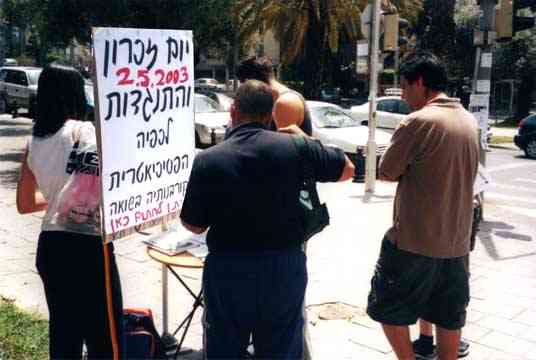
| May 2nd - Day of Remembrance and Resistance |
|
International Commemoration 2003 |
Documentation
International events: Current year Previous international events:
|
Press
reaction: ENGLISH - DEUTSCH: Frankfurter
Rundschau - Neues Deutschland - Junge
Welt
|
Call for the 9th T4 demonstration on 2 May 2003, beginning at 2 p.m. in Tiergartenstr. 4, near the entrance to the Philharmonic Concert Hall: "The
remaining after the selection" move on The 2nd of May having been internationally chosen as a day of remembrance of the medical mass murder by the German doctors from 1939-1948 and as a "Day of Remembrance & Resistance" against psychiatric coercion, we have decided to change the date of our annual T4 demonstration to that day as well. We welcome the choice of May 2nd as a day of resistance, the day in 1998 on which the verdict of the Foucault Tribunal was announced. The demonstration begins with the second public vernissage of the exhibition "The Missing Link" with the assemblage sculptures by Igael Tumarkin. |
|
Aufruf zum 9ten T4 Umzug am 2. Mai 2003, Beginn um 14.00 Uhr, Tiergartenstr. 4, beim Eingang zur Philharmonie: Selektionsreste im Aufbruch Nachdem international der 2. Mai als Tag der Erinnerung an den medizinischen Massenmord in Deutschland von 1939-1948 und als Tag des Widerstands gegen die Zwangspsychiatrie vereinbart wurde, verlegen wir unseren T4 Umzug ebenfalls auf diesen Tag. Wir begrüßen, daß mit der Wahl dieses Tages der 2. Mai als der Tag, an dem das Urteil des Foucault Tribunal verkündet wurde, in Erinnerung gerufen wird. Der Umzug beginnt mit der zweiten öffentlichen Vernissage der Ausstellung "The missing Link" mit den Assemblagen von Igael Tumarkin. |
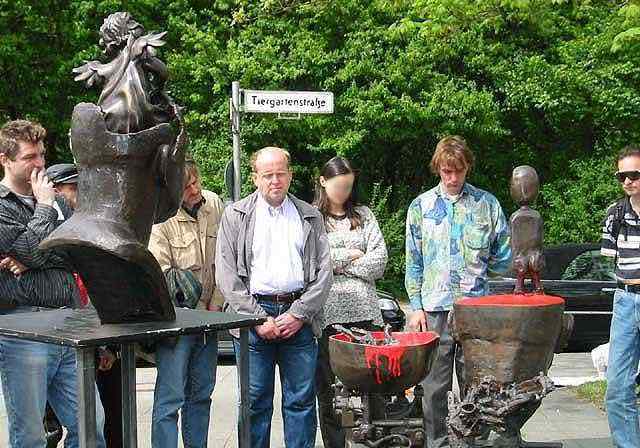
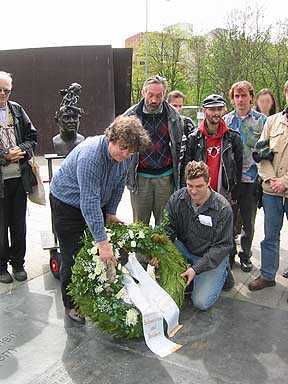 |
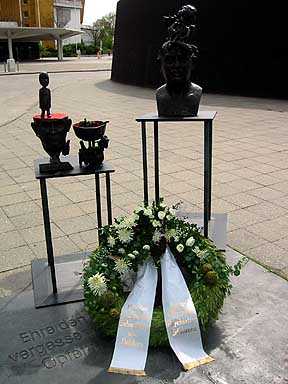 |

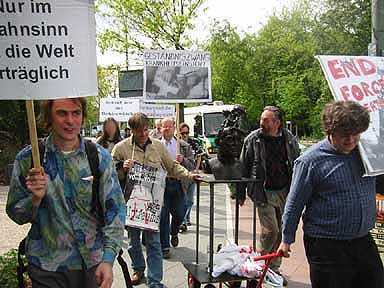
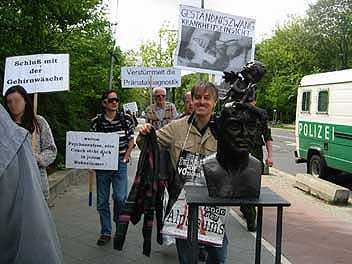
Mira de Vries read the following speech in the square between the Rijksmuseum and the Van Gogh Museum. (Original version in Dutch, click here)
Commemoration of people murdered by psychiatrists between 1939 - 1945
Ladies and Gentlemen,
Today in different places around the globe the people murdered by psychiatrists in the years 1939 through 1945 are being commemorated.
In the Netherlands some of us are surely sighing: commemorating again? Does every group of murdered people have to be commemorated? The answer is yes, because not remembering is repeating.
But this group, what does it have to do with us? Some people will wonder. The murdered people were mostly Germans. The murderers were mostly Germans.
Yes, the murdered people were mostly Germans, but they were not murdered because they were Germans. They were murdered because they deviated from norms set by doctors, norms for behavior, belief, intelligence, social skills, physical perfection, and financial functioning. When Jews, Romas, dark-skinned people, or homosexuals were murdered, some people could think, "Fortunately I'm not Jewish, Roma, dark-skinned, homosexual" or whatever. But nobody could think, "Fortunately I'm not feeble," because feebleness can happen to anybody. Nor did the ideology of the murderer-doctors stop at the borders of German-speaking countries. All of us would have been potential victims of the mass murder program. That is why we, too, are commemorating the murders today. Not remembering is repeating.
Who were the people we are commemorating today? We don't know the names of most of them. How many were there? According to Fredric Wertham, himself a German psychiatrist who emigrated to the United States in 1922, there were at least 275,000 in Germany alone. I could not find a source telling me how many were murdered in Austria, only that entire psychiatric hospitals were emptied. A different source reveals that also in occupied France 40,000 people in institutions were killed by psychiatrists. In Poland inhabitants of institutions were shot to death by occupying forces. Perhaps in total 400,000 would be a fair estimate. The Roma and Sinti people (incorrectly called Gypsies) and Jews, whose mass murder was also considered a "hygienic measure" by the nazis, are not included in this figure. We already call the simultaneous murder of four or eight people "mass murder." Numbers like 400,000 could obscure from us that we are talking about individuals, human beings, robbed of life because the doctors of their day considered that medically necessary. Those individuals we are commemorating today, because not remembering is repeating.
Who were their murderers? Scores of their names are known. They were revered scientists and doctors, professors of universities, managers of psychiatric hospitals, men and women. In their private lives they were considered kind, gentle people. They had the best of intentions. Many had published material that to date is still quoted in text books studied by aspiring young physicians. Not remembering is repeating.
Several misconceptions exist about the murders, often based on what we would like to believe. One such misconception is that the psychiatrists did what they did involuntarily, that they were somehow compelled by Hitler, under threat of penalty. The opposite is true.
Psychiatrists lobbied Hitler for permission to carry out their so-called "euthanasia program". It was a logical consequence of their sterilization program in which from 1934 400,000 men, women and children in Germany were involuntarily rendered sterile, sometimes because of the most trivial of conditions. The sterilization stopped in 1939. It was only a small step from mass sterilization to mass murder. Incidentally, the activities of the top physician of that sterilization program, Ernst Rüdin, were sponsored by the Rockeffeler Foundation in the United States, not by the nazis. Most of the sterilized people were later murdered.
Although the idea existed already, notably in England and the United States, the mass murder program was designed in a scientific book written in Leipzig, Germany, in 1920. The authors were the attorney Karl Binding and the psychiatrist Alfred Hoche, both professors. Binding and Hoche argued that the human race should be purified by removing deviant people from it. All forms of deviance were assumed to be transmittable to future generations through genes. Binding and Hoche recognized that occasionally a non-deviant person might accidentally be included in the procedure, but they felt that that risk was justified considering the benefit of a future society without deviant people in it.
Binding and Hoche's proposal became immensely popular among supporters of "eugenics" both inside and outside of Germany. Professors and department heads of the medical faculties of Berlin, Heidelberg, Bonn, and Würzburg organized conventions to persuade legislators and judges. The American Psychiatric Association proposed adopting the program in the United States, where involuntary sterilization continued even after 1945. The British "Eugenics Society" which was founded before the German mass murder program and to this day still exists endorsed it. Favorable reports were also published in Switzerland and other European countries. Binding and Hoche had not yet heard of Adolph Hitler. On the contrary, it was Hitler who would be strongly influenced by the beliefs that were the fashion in the psychiatry of his day.Psychiatrists were not compelled to participate. There are known cases, though very few, of physicians who refused. They were not molested by the nazis or other physicians, as long as they did not speak out publicly against the program.
A second misconception is that the murderers were exceptions, a minority of medical thugs, and their crimes sporadic or cases of over-zealousness. Impossible. For every murdered person all sorts of formalities were completed, registrations, questionnaires in four copies, this commission and that commission, this decision and that decision, rubber stamp from here and signature from there. Not one of the murdered people was killed casually. To guard against perversion of the process of selection, psychiatrists were not allowed to decide about the dwellers of their own institutions. Today in this country this principle still applies. We call it the "independent psychiatrist" who is "not the own therapist".
The mass murders were based on ideology. In 1941 in a psychiatric hospital called Hadamar staff assembled to celebrate the death of the 10,000st victim. His naked body was ceremoniously shoved into the cremating oven. There was music, a mock religious ritual conducted by a psychiatrist, and each member of staff received a bottle of beer as a memento.
A third misconception is that most psychiatrists themselves did not know about it or participate. In fact, only renowned psychiatrists were invited to join the effort. The architects of the mass murder program were distinguished psychiatrists. The selection of candidates for murder was done by psychiatrists, scores, if not hundreds of them, who manned all those committees. The murders were physically committed by psychiatrists. Psychiatrists conceived and ordered the erection of the gas chambers and crematoria at five major psychiatric hospitals, and at one former jail to be used solely for mass murdering institutionalized people. Psychiatrists themselves opened the gas valves, while other psychiatrists observed the asphyxiating people through a little window in the side of the gas chamber. Psychiatrists of institutions that had no gas chamber willingly cooperated with transporting their dwellers to other institutions, where there were gas chambers. Or they killed their dwellers with psychotropic drugs, either by injection or by mixing them through the food. Other dwellers were intentionally starved to death on so-called scientific diets. Particularly thousands of children were murdered by psychoactive drugs and starvation.
A forth misconception is that the mass murders were committed in sympathy for the supposed suffering of the victims. This claim was successful at several of the trials that were later brought against some of the mass murderers. Aside from the fact that the murders were far from humane, aside from the fact that the dwellers had not asked to die, it is not true that only severely ill or disabled people were murdered. The criteria were constantly expanded and included: children with malformed ears, children who wet their beds, elderly people who weren't as fit as they once had been, blind and deaf people, people who occasionally had epileptic seizures, veterans of the first World War who had lost a limb in the line of duty, and people who, not having a demonstrable impairment, were called "schizophrenic." Some people had no impairments at all, but were incarcerated, if they were adults, because of homelessness, unemployment, or petty crimes. For some people a court order for their release arrived after they had been murdered. Some of the mass murdered children were incarcerated because of problems in the home.
When the population of the institutions began to thin out due to the mass murders, threatening psychiatrists' jobs, they visited families in their homes and persuaded them to send Grandma or Granddad to an institution where there was expert care. They threatened parents who were reluctant to institutionalize their child that they would have the parents' custody of the child revoked if they continued to refuse care for their children. That care was murder.
There is controversy whether the psychiatrists' aims were purely medical. In their books, articles, speeches, and letters, they repeatedly stressed the economic benefits of the mass murder program. The nation would be spared the cost of caring for non-productive people. The murdered people would leave their belongings, homes, clothes, and utensils behind. The bodies themselves had economic value. Gold teeth were collected. Soap could be produced from the fat, bags from skin, mattresses from hair, and of course, the brains were very much wanted by colleague physicians for scientific research. The revenue was monitored by the Central Accounting Bureau in Berlin. I want to remind you, these were psychiatric hospitals. The so-called "death camps" were not erected until 1941. I personally am convinced that the psychiatrists were not motivated by economic benefits, but used this argument for propaganda purposes.
In 1941 some psychiatrists were transferred from their psychiatric hospital to work in the concentration and death camps. During the trial of one such psychiatrist, he was asked, "How could you have gone from selecting psychiatric patients to selecting regular people?" Apparently the prosecutor did not understand what the prosecuted did understand. He answered, "There's no difference." Psychiatric patients are human beings like the rest of us.
A sixth misconception is that the psychiatric murders stopped in 1941.
That year Hitler did speak to the manager of the mass murder program, Karl Brandt. Exactly what was said is not written. The sources that I consulted are divided over whether Hitler entirely withdrew his permission for the program, or whether he only requested Brandt to moderate it. The sources are equally divided about the reason that Hitler made this request. Some suggest that Hitler caved in to pressure from the public, particularly priests, neighbors to the institutions with crematoria, and dissident psychiatrists. Others postulate that Hitler was concerned about morale among the troops. Soldiers returning home for a visit discovered that little sister or Granny had mysteriously disappeared, or they worried that if they were wounded, they might themselves be candidates for the mass murder program. A third possibility is that Hitler wished to designate a different employment for the gas chambers. In 1941 they were dismantled, shipped to the east, and erected anew in the concentration turned murder camps. Teams of doctors and nurses traveled with the equipment to train death camp commanders in their use.
But the mass murders of psychiatrized people continued in 1941 and after, also without the gas chambers. Psychotropic drugs and intentional starvation had been widely used already, and after 1941 would become the main instrument of mass murder. Because these mass murders were no longer sanctioned by the government, and because they no longer involved so much bureaucracy, they were dubbed "wild euthanasia." Most historians agree that even more mass murders of infirm people were committed after 1941 than in the two previous years. In 1945 American soldiers rescued 20 children by liberating a psychiatric hospital called Eglfing-Haar at gun-point. Perhaps some of those 20 children are still alive today.
We recognize the names of many concentration and death camps because we commemorate the people who were murdered in them. Without the tools created by psychiatrists for psychiatric inmates, the history of the death camps would not have been the same. It is high time that we commemorate the people who were murdered in the psychiatric hospitals, because not remembering is repeating.
What became of the thousands of psychiatrists and others who committed the mass murders? A few, among whom the manager of the mass murder program, Karl Brandt, and his assistant, Paul Nitsche, were executed at Nuremberg. Many other top officials in the program escaped justice by committing suicide. Werner Heyde, inspector of the gas chambers, lived and worked twelve years under an assumed name, although his identity was known to his colleagues. After being discovered, he too committed suicide. Some psychiatrists served relatively short prison terms, such as Valentin Falthauser, who ordered the murder of at least 300 people. He was sentenced to three years, slightly more than 3½ days per known victim. Another psychiatrist, fat Hermann Pfannmüller, who, aside from adults, killed 120 children between the ages of one and five by so-called natural means, namely intentionally starving them to death, served six days per murdered child. Most of the psychiatrists who did not commit suicide were acquitted, if indeed they were tried at all, and continued their careers, be it in Europe or in the United States. Among other activities, they trained a new generation of psychiatrists. One of the most prominent psychiatrists in the mass murder program, Werner Villinger, was decorated by the West German government and in 1950 upon invitation, participated in a White House conference on children and youth in the United States. Another mass murderer, the psychiatrist Fredrich Maurz, was involved in 1948 in the founding of the World Federation of Mental Health. You won't find that information on their web site. In the 1980s an American writer interviewed scores of physicians who were involved in mass murders. He could do so because they were living and working in freedom. Also the other people involved, nurses, assistants, administrators, students, pharmacists, builders, plumbers, and the suppliers of the gas, went scot-free.
One of the participants in the Nuremberg tribunal was Leo Alexander, psychiatrist from the United States. It was he who persuaded the prosecutors not to consider the involuntary sterilization program as a crime, as involuntary sterilizations were being carried out in the US as well. In cases brought later than the Nuremberg tribunal, German judges demonstrated sympathy for the psychiatric mass murder program, leading to mild sentences or acquittals. We must not forget that the German justice system was intrinsically involved in the mass murder program.
While preparing this speech, I wondered whether publications by the mass murderers can still be read in this country. I consulted the library catalogues of the two universities in Amsterdam. And so it is. Karl Brandt, head of the mass murder program, who was executed at Nuremberg, many hits. And yes, I counted only the hits regarding the correct Karl Brandt, because there are indeed multiple authors by that name. Paul Nitsche, also executed, 5 hits. The thesis written by Pfannmüller, the tot torturer, also available. Max de Crini(s), the Berlin professor who inspected the gas chamber at Sonnenstein hospital by watching the deaths through the little window, 6 hits. Werner Catel, the expert child murderer, hits. Berthold Kihn, the administrative mass murderer, hits. Villinger, who I mentioned earlier, a publication from 1958, thirteen years after the demise of the nazi regime. And I went on to find hits for almost all of the names that I typed. Binding and Hoche's book that was the basis for the mass murders is also available. Who knows how many publications by psychiatric mass murderers are studied by young trainee physicians in our country, or yours.
Mein Kampf by Hitler is also available. I am not advocating censure. But the difference between Hitler and psychiatric mass murderers is that every child in the country knows that Hitler was a mass murderer. The names of the psychiatric mass murderers who inspired Hitler are unknown. I am advocating that we educate ourselves about the events in the psychiatric hospitals in those years. The French say, l'histoire se repete. History repeats itself only when we don't learn it. To learn this shameful history, we have to commemorate the victims. Not remembering is repeating.
Why have these murders never been commemorated in this country before? Why are they hushed up? Could it be because we, too, until this day, count on psychiatrists to remove deviant people from our midst?
Today's psychiatrists do not aim to commit mass murder. But there are parallels. Nowadays we do not speak of "the people" (volk) but of society. Psychiatrists are still trained to see humans as body and genes. Although the syllable "psych" means soul, the soul has no role in modern biopsychiatry anymore than it had a role in the psychiatry of the third reich. Instead of mass murder we now have mass medication. The boundary between "tranquilized" and "dead" has been moved somewhat. By this I am referring to the testimony by one of the psychiatrists, that it didn't make much difference whether somebody was dazed or dead. The undemonstrated and unprovable diagnoses are now not on the death certificates but in the medical files. Parents of children are still pressured by psychiatrists. The doors to some institutions are still locked from both sides, keeping the incarcerated people in and journalists out. Dissident psychiatrists who do not succumb to the beliefs and practices of the masses are still discredited by colleagues and denied employment.
The pseudo-medical jargon is also still part of psychiatry. Back then, violence was called "care", murder was called "euthanasia", death from drugs was called "natural death", person was called "patient", and not understood was called "schizophrenic." Now we have added terms such as "compliance" and "insight into illness" to express submission to psychiatrists.
The symbiotic relationship between medicine and government is stronger than ever, a mariage à convenance between law and science, between physician and the power of the court, which override the self-determination of the law-abiding individual.
Ladies and Gentlemen, we plan to be here again next year to commemorate, because not remembering is repeating.
We call on psychiatrists and other physicians, psychiatric and other nurses, professors, teachers, and students, all who are directly or indirectly involved in caring for people in institutions, to come and commemorate with us next year, because not remembering is repeating.
We call on politicians, judges, lawyers, civil servants, health insurers, board members of institutions and universities, and everyone else who is directly or indirectly involved in the administration of decisions regarding the fate of people called patients, to come and commemorate with us next year, because not remembering is repeating.
We call on the leaders and practitioners of all religions, the adherents of all philosophies, and citizens of all occupations, to come and commemorate with us next year, because not remembering is repeating.
We call on psychiatrized people, those who still can walk, talk, think, feel, remember, and function independently, to come and commemorate with us next year, because not remembering is repeating.
We call on Governments to publish the names of the mass murdered people in psychiatric institutions. And for every name, tell us the age of that person at the time of his or her murder, and tell us the diagnosis that fated that person. Give us the opportunity to form some kind of mental image of these people, so that we can remember that indeed they were human beings like ourselves, because not remembering is repeating.
We are here today to commemorate circa 400,000 men and women, children and elderly people, with major impairments, minor impairments, and no impairments, victims of the scientific values of their time, victims of those who thought they could engineer the human race, victims who were selected and murdered by the psychiatrists who claimed to treat them in their best interests. May their souls find blessing in this commemoration.
Ladies and gentlemen, I suggest we end this commemoration ceremony with a minute of silence.
International Commemoration Committee on Eugenic Mass Murder
in association with
Association for Medical and Therapeutic Self-determination in the Netherlands (MeTZelf)
MeTZelf-owner@yahoogroups.com
Sources: